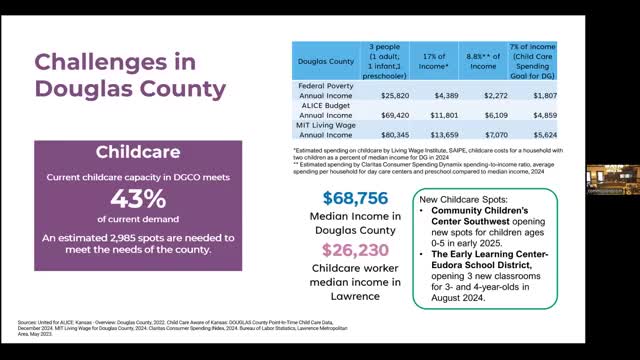Douglas County proposes childcare expansion and guaranteed income pilot for low-income families
July 02, 2025 | County Commission, Douglas County, Kansas
This article was created by AI summarizing key points discussed. AI makes mistakes, so for full details and context, please refer to the video of the full meeting. Please report any errors so we can fix them. Report an error »

During the Douglas County Commissioners Meeting on July 2, 2025, significant discussions centered around addressing pressing social issues, particularly childcare availability and economic mobility for low-income families. The meeting highlighted the urgent need for more childcare spots in the county, as current spending on childcare consumes approximately 8.8% of a family's income. This figure is concerning, as it places a financial strain on families, particularly those with limited resources. The goal is to reduce this percentage to around 7%, which would alleviate some of the economic burden on families.
The meeting also shed light on the financial challenges faced by childcare workers, whose median annual wage of approximately $26,000 falls below the federal poverty line for a family of three. This situation underscores the broader issue of low wages in sectors that predominantly employ women, particularly those of childbearing age. The data presented indicated that none of the top twelve industries for women in Douglas County provide incomes above the ALICE (Asset Limited, Income Constrained, Employed) threshold, emphasizing the need for better-paying job opportunities in the region.
A key initiative discussed was the proposed guaranteed income pilot program aimed at supporting low-income women with children in Douglas County. This program is set to launch by 2027 and is designed to provide financial stability to families, thereby improving their overall well-being. The community has already engaged in discussions and data walks to raise awareness about the concept of guaranteed income, showcasing success stories from other regions.
Additionally, the meeting addressed the development of a community navigator program aimed at increasing access to essential services such as SNAP and WIC for low-income, single female-headed households. This initiative seeks to bridge the gaps in service delivery, which often leave vulnerable populations without the support they need. By 2027, the goal is to increase the utilization of these benefits from 10% to 50% among the targeted demographic.
In conclusion, the discussions at the Douglas County Commissioners Meeting highlighted critical social challenges and proposed actionable strategies to improve the economic conditions for families in the area. The focus on childcare, guaranteed income, and community navigation reflects a comprehensive approach to tackling poverty and enhancing the quality of life for residents. As these initiatives progress, they hold the potential to create lasting positive change in Douglas County.
The meeting also shed light on the financial challenges faced by childcare workers, whose median annual wage of approximately $26,000 falls below the federal poverty line for a family of three. This situation underscores the broader issue of low wages in sectors that predominantly employ women, particularly those of childbearing age. The data presented indicated that none of the top twelve industries for women in Douglas County provide incomes above the ALICE (Asset Limited, Income Constrained, Employed) threshold, emphasizing the need for better-paying job opportunities in the region.
A key initiative discussed was the proposed guaranteed income pilot program aimed at supporting low-income women with children in Douglas County. This program is set to launch by 2027 and is designed to provide financial stability to families, thereby improving their overall well-being. The community has already engaged in discussions and data walks to raise awareness about the concept of guaranteed income, showcasing success stories from other regions.
Additionally, the meeting addressed the development of a community navigator program aimed at increasing access to essential services such as SNAP and WIC for low-income, single female-headed households. This initiative seeks to bridge the gaps in service delivery, which often leave vulnerable populations without the support they need. By 2027, the goal is to increase the utilization of these benefits from 10% to 50% among the targeted demographic.
In conclusion, the discussions at the Douglas County Commissioners Meeting highlighted critical social challenges and proposed actionable strategies to improve the economic conditions for families in the area. The focus on childcare, guaranteed income, and community navigation reflects a comprehensive approach to tackling poverty and enhancing the quality of life for residents. As these initiatives progress, they hold the potential to create lasting positive change in Douglas County.
View full meeting
This article is based on a recent meeting—watch the full video and explore the complete transcript for deeper insights into the discussion.
View full meeting
